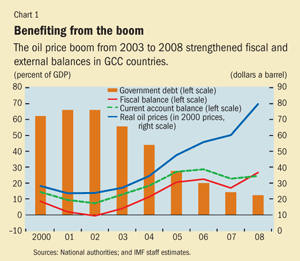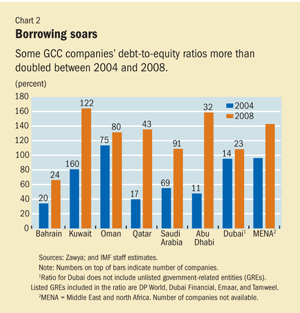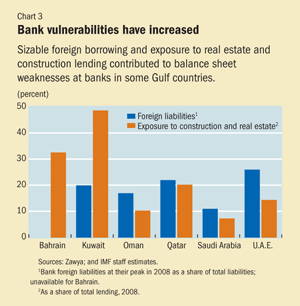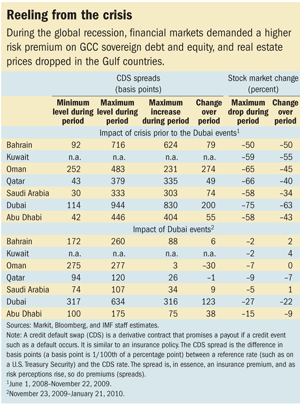Learning from the Past
Finance & Development, March 2010, Volume 47, Number 1
May Khamis and Abdelhak Senhadji
Countries of the Gulf Cooperation Council confronted the global financial crisis from a position of strength
The Gulf Cooperation Council
The Gulf Cooperation Council (GCC) was established in 1981 by Bahrain, Kuwait, Oman, Qatar, Saudi Arabia, and the United Arab Emirates to enhance their economic and financial integration. Its total population—including expatriates—is estimated at about 38 million, with a GDP of $1.1 trillion in 2008. Oil accounts for about 50 percent of the region’s GDP and 80 percent of fiscal and export revenues. The region plays a major role in oil markets, accounting for about 50 percent of Organization of Petroleum Exporting Countries (OPEC) production and 70 percent of OPEC’s spare production capacity, with 58 percent from Saudi Arabia alone. The currencies of all GCC countries except Kuwait are pegged to the U.S. dollar. The region is home to some of the largest and oldest sovereign wealth funds, with assets under management estimated to be between $600 billion and $1 trillion at end-2008, excluding more than $500 billion in official reserves.
THE countries of the Arabian Peninsula are familiar with the vagaries of oil markets. Flush with petroleum revenues in the 1970s, when oil prices recorded a long period of prosperity, the nations in the Gulf Cooperation Council (GCC) experienced high levels of government spending, only to face harsh budget realities when oil prices plummeted.
With the most recent crisis, oil prices declined precipitously from their peak of $144 a barrel in mid-2008 to $34 in December of that year, owing largely to the fall in demand worldwide. But this time, the six governments of the GCC (see box) saved a significant portion of their oil revenue from the 2003–08 oil boom, accumulating reserves and amassing large sovereign wealth funds. They spent prudently, investing in physical infrastructure and human capital. Some countries paid down debt (see Chart 1)—Saudi Arabia, for example, reduced its debt to 13 percent of GDP by the end of 2008, from more than 100 percent a decade earlier.
As a result, GCC governments were able to contain the impact of the worst global economic crisis in decades, although the recent turmoil has revealed some financial sector vulnerabilities in the region.
Emerging imbalances

The oil price boom led to strong fiscal and external balance surpluses in the GCC countries. These surpluses provided the fiscal space necessary, at least for a while, to address the region’s twin challenges of promoting economic diversification and reducing unemployment while preserving oil wealth for future generations.
But the boom also generated domestic imbalances that began to unravel with the  onset of the global credit squeeze—abundant liquidity fueled credit growth, inflation, and asset price increases in a context of limited countervailing policy tools in view of the peg to the U.S. dollar. The boom was also associated with higher financial and corporate sector leverage (see Chart 2). Balance sheet vulnerabilities became visible with the onset of the global credit squeeze, particularly in the United Arab Emirates (U.A.E.), Kuwait, and Bahrain, given their linkages with global equity markets, growing dependence on foreign lending, and exposure to real estate and construction lending (see Chart 3).
onset of the global credit squeeze—abundant liquidity fueled credit growth, inflation, and asset price increases in a context of limited countervailing policy tools in view of the peg to the U.S. dollar. The boom was also associated with higher financial and corporate sector leverage (see Chart 2). Balance sheet vulnerabilities became visible with the onset of the global credit squeeze, particularly in the United Arab Emirates (U.A.E.), Kuwait, and Bahrain, given their linkages with global equity markets, growing dependence on foreign lending, and exposure to real estate and construction lending (see Chart 3).
Swift response

As global deleveraging took hold and oil prices and production dipped, the GCC’s external and fiscal surpluses declined markedly, credit default swap (CDS) spreads on sovereign debt widened, and stock and real estate markets plunged (see table). The U.A.E. real estate market was hit hard as the monthly value of real estate transactions tumbled from their peak of close to $3 billion in May 2008 to a mere $250 million by November 2009. External funding for the financial and corporate sectors tightened: of an estimated $2.5 trillion in projects in the works at end-2008, about $575 billion had been suspended by end-2009.

Still, banks remained profitable and were able to absorb losses, largely because capital adequacy ratios in most countries were high going into the crisis. A few nonbank financial institutions and business groups did default, but without systemic consequences—in part because governments took swift action to ensure stability.
To offset the shocks, governments used their strong international reserve positions to maintain high spending and introduce exceptional financial measures. In addition to liquidity injections by central banks and governments, Kuwait, Saudi Arabia, and the U.A.E. provided deposit guarantees. Moreover, Qatar and the U.A.E. injected capital amounting to up to 2 percent and 7.3 percent of GDP, respectively. Kuwait passed a financial stability law that provided substantial financial sector guarantees and set up stock market stabilization funds for up to 3.0 percent of GDP via various government entities. Qatar purchased up to 6 percent of GDP of banks’ equity and real estate assets. As part of a $400 billion investment plan over five years, Saudi Arabia implemented a stimulus package that was the largest (as a share of GDP) of any of the so-called Group of 20 advanced and emerging economies. These measures helped stabilize the GCC financial systems and sustain growth, had positive spillovers for neighboring countries, and contributed to reviving global demand.
Dubai hit by the credit crunch
The region appeared to be weathering the global economic crisis well. But pressures on highly leveraged quasi-sovereign entities in Dubai culminated in November 2009 when Dubai World, a government-owned holding company, announced that it would seek a debt standstill—in other words, negotiate an agreement with its creditors to modify the original credit terms and avoid foreclosure proceedings.
These developments were the result of a series of events: Dubai government-related entities had borrowed extensively in 2004–08 to fund a major push into commercial and residential property. The significant increase in leverage led to a real estate bubble, which burst in mid-2008.
The government of Abu Dhabi, which as the largest of the seven emirates owns more than 95 percent of the U.A.E.’s oil reserves, came to Dubai’s rescue on December 14, providing a loan to cover some of Dubai World’s debt obligations, including about $4.2 billion in Islamic bonds (sukuk) of its real estate subsidiary Nakheel, which matured on the same date. The intervention helped calm markets, but uncertainties remain as the government of Dubai develops a strategy to put its corporate sector on a viable path.
As a result of the developments in Dubai, temporary pressures on the region’s equity markets have reemerged, and CDS spreads on the Dubai government and entities have increased. (CDS spreads for the rest of the region have been only marginally affected.) Dubai’s difficulties may affect the rest of the region in other ways. For instance, markets are likely to take a less sanguine view of quasi-sovereign and private risk, which may increase the cost of borrowing and reduce access to international capital markets for some GCC entities.
What’s ahead
While the GCC’s short-term economic outlook is clouded by the global crisis and by recent developments in Dubai, the region’s medium-term outlook remains broadly positive, supported by rising commodity prices. Non-oil GDP growth is estimated to have been about 2.8 percent in 2009, and the rebound in overall growth in 2010 is expected to be stronger than in advanced economies.
Still, there is much work ahead for GCC policymakers. The immediate priority is the cleanup of bank balance sheets (that is, continued upfront recognition of losses and immediate bank recapitalization) and the restructuring of the nonbanking sector in some countries. Stress testing and periodic reviews of banks’ asset quality will help determine whether the level of capital support is sufficient. Where possible, recapitalization should be based on private sector investments to minimize moral hazard, and the authorities should reverse public sector injections as soon as market conditions allow it.
The authorities should also facilitate the restructuring of nonbank institutions—particularly in Kuwait and the U.A.E— by supporting systemic and viable entities while ensuring a smooth exit of nonviable ones. Clear communication by the authorities would help implementation, ease investor uncertainty, and reduce speculation and market volatility.
Over the medium term, improving corporate governance and transparency will be paramount in view of heightened lender risk aversion, which has put pressure on GCC conglomerates and government-related entities to do a better job of disclosure.
The region’s authorities should also consider the following measures:
- a fiscal policy supported by an adequate set of macroprudential tools aimed at dampening the transmission of the oil cycle to the economy, given the limitations of monetary policy because of the peg to the U.S. dollar;
- regulations to promote prudent loan-loss provisioning—as seen with Saudi Arabia, which has already been implementing countercyclical provisioning policies—and capital buffers over the business cycle;
- active enforcement of reserve requirements and prudential limits on banks to tackle any resumption of speculative inflows and overheating pressures;
- a capital gains tax on property and equity transactions;
- avoidance of excessive corporate sector leverage and monitoring of spillover risks from offshore financial centers; and
- the development of local and regional debt markets to diversify financing channels away from banks.
To reach the longer-term goal of diversifying their economies, GCC governments should focus on facilitating private sector activity. To that end, improving the regulatory environment and eliminating red tape are key. Not only would diversification generate employment, it would also help the region achieve the fundamental goal of reducing its dependence on oil.


